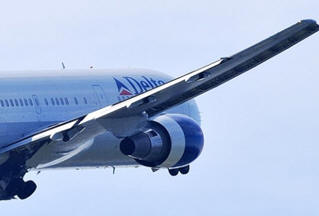|
|||||||||||
|
|
|
|||
|
By |
||||
 |
September 22, 2010
- This is the 25th consecutive decrease in full-time equivalent employee (FTE) levels for the scheduled passenger carriers from the same month of the previous year. FTE calculations count two part-time employees as one full-time employee. BTS, a part of the Research and Innovative Technology Administration reported that the July FTE total of 378,100 for the scheduled passenger carriers was 8,700 below that of July 2009. |
|||
|
|
||||
|
Five network airlines decreased employment from July 2009 to July 2010. The sixth network carrier, Delta Air Lines, after completing its merger with Northwest Airlines, is reporting combined employment numbers in 2010 and reported 5.7 percent more FTEs in July 2010 than the combined totals of both carriers for July 2009. Network airlines operate a significant portion of their flights using at least one hub where connections are made for flights to down-line destinations or spoke cities. Southwest Airlines and AirTran Airways were the only low-cost carriers to report a decrease in employees from July 2009. Five low-cost carriers reported an increase in employment. Regional carriers Comair, Atlantic Southeast Airlines, Pinnacle Airlines, Horizon Air, Mesa Airlines, Air Wisconsin Airlines, Mesaba Airlines, Shuttle America Airlines, and Lynx Airlinesalso reported reduced employment levels compared to last year. Scheduled passenger airline categories include network, low-cost, regional and other airlines. The six network airlines employed 256,400 FTEs in July, 67.8 percent of the passenger airline total, while seven low-cost carriers employed 16.9 percent and 18 regional carriers employed 13.8 percent. Delta employed the most FTEs in July among the network airlines, Southwest employed the most FTEs among low-cost airlines, and American Eagle employed the most FTEs among regional airlines. Six of the top 10 employers in the industry are network airlines. Beginning with October 2007 data, US Airways' numbers are combined with numbers for America West Airlines in the network category. For previous months, America West's numbers were included with the low-cost airlines. |
||||
|
Network Airlines: FTEs at the group of six network airlines decreased 1.6 percent in July 2010 compared to July 2009, the 23rd consecutive monthly decrease from the same month of the previous year. The network airlines employed 4,100 fewer FTEs in July 2010 than in July 2009. Delta and Northwest reported separately in July 2009 while their reports were combined in July 2010. Within the group, all network carriers except Delta decreased FTEs from July 2009 to July 2010: Continental Airlines, 6.0 percent; US Airways, 5.5 percent; United Airlines, 3.7 percent; American Airlines, 3.4 percent; and Alaska Airlines, 3.3 percent. Delta increased FTEs by 5.7 percent compared to total Delta and Northwest FTEs for July 2009. The network airlines employed 8,500 fewer FTEs in July 2010 than in 2006 even though America West's numbers were not combined with US Airways in the network category until October 2007. The biggest percentage decline in FTE employment from 2006 to 2010 was at United, down 17.6 percent, a reduction of 9,300 FTEs, followed by American, down 10.3 percent. July 2010 numbers for Delta and US Airways are not comparable to 2006 because of the intervening mergers. Low-Cost Airlines: Low-cost airline FTEs were up 1.5 percent in July 2010 from July 2009. Five low-cost airlines reported year-to-year increases: Frontier Airlines, 10.7 percent; Allegiant Air, 9.2 percent; Virgin America, 8.9 percent; Spirit Airlines, 8.2 percent; and JetBlue Airways, 4.1 percent. Southwest and AirTran reported year-to-year FTE decreases. The six low-cost carriers reporting employment data in both 2006 and 2010 employed 11.6 percent more FTEs in July 2010 than in July 2006. Allegiant reported the largest percentage increase, up 117.6 percent. Low-cost airlines are those that the industry recognizes as operating under a low-cost business model, with lower infrastructure and aircraft operating costs. Regional Airlines: Regional airline FTEs were down 7.5 percent in July 2010 compared to July 2009, the 23rd consecutive month with a decline from the same month of the previous year. Comair, down 52.3 percent, and Mesaba, down 44.4 percent, reported the largest decreases in the regional group. Republic Airlines, up 34.4 percent; and Compass Airlines, up 16.4 percent, reported the largest increases in the group. Regional carrier FTEs declined 8.6 percent from July 2006 to July 2010.
The 15 regional
carriers reporting employment data in both 2006 and 2010 employed 11.0
percent fewer FTEs in 2010 than in 2006. Comair reported the largest
percentage decline, down 58.2 percent, followed by
Republic reported
the biggest four-year gain, 273.1 percent, followed by GoJet at 73.8
percent. Effective with October 2009 reporting, Republic's employment
numbers include FTE's from Midwest Airlines. |
|
|
| Other News Stories |
| ?AvStop
Online Magazine
Contact
Us
Return To News
|
|


